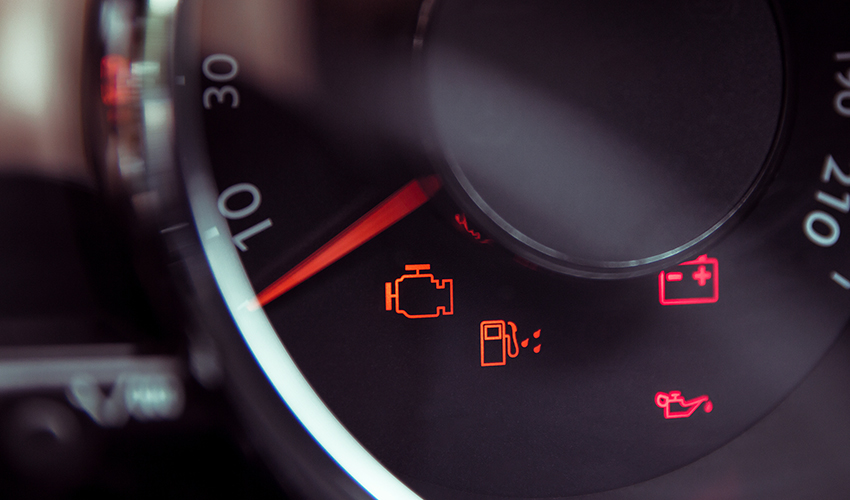What are DTC Codes? The Complete Diagnostic Trouble Code Guide

All modern fleet vehicles have built-in computers that monitor performance. When an issue occurs, the check engine light is activated and a DTC (diagnostic trouble code) is generated to pinpoint the problem.
In this guide, we’ll cover everything you need to know about on-board diagnostic systems and DTC meanings to help keep your fleet in peak condition.
What is a DTC code?
DTC stands for diagnostic trouble code. Also known as a DTC engine code, engine fault code, or check engine light codes, these codes are usually five characters long. DTC codes are typically one letter followed by four numbers.
Diagnostic trouble codes were originally developed by the Society of Automotive Engineers (SAE) to help fleet vehicles comply with emission regulations under the Clean Air Act. Each DTC is standardized and relates to a particular vehicle part.
How do DTC codes work?
The check engine light can signify one of many problems. Some fixes are straightforward, while others require serious downtime when the problem is not rectified immediately. This is why it’s vital that the check engine light is not ignored, and that drivers identify the code and DTC severity as soon as possible to ensure the best outcome.
On-board computer diagnostic system
When the check engine light comes on, drivers can access diagnostic trouble codes with a scanner that plugs directly into the on-board diagnostic system (OBD). Usually, the OBD-II port is located somewhere on or around the dashboard, often where a GPS tracker is connected. Please see this resource for more information on J1939 ports.
Understanding DTC meanings can help drivers know precisely what the problem is and where it lies. However, there are hundreds of possible engine fault codes. So, how do drivers know what each one means?
How to read diagnostic trouble codes (DTCs)
DTC codes are five characters long, and each character in the DTC means something different about the vehicle’s issue. In order to understand the DTC, one must go digit by digit. Here’s how to read each character of a DTC.
First DTC character
The first character =
- P Codes - P stands for powertrain, meaning the issue is related to engine functions, transmission, or drivetrain.
- C Codes– C codes cover chassis functions such as steering, suspension, and brakes.
- B Codes – Vehicle body codes refer to safety and comfort features inside the driver’s cabin.
- U Codes – U codes cover all the network and vehicle integration functions that the OBD manages.
Second DTC character
The second character is a numeric digit. It’s almost always 0 or 1:
- 0 – A zero means the code is generic and applicable to all vehicles following the SAE OBD-II international standard. In fleet management, this encompasses the vast majority of vehicles.
- 1 – This denotes a manufacturer-specific code, which is not generic across all vehicles.
Third DTC character
Whenever the second character is a zero, the third character tells you which subsystems are at fault. There are eight categories:
- 0 – Fuel and air metering, and auxiliary emission controls
- 1 – Fuel and air metering
- 2 – Fuel and air metering (injector circuit)
- 3 – Ignition systems or misfires
- 4 – Emission controls
- 5 – Vehicle speed control, idle control systems, and auxiliary inputs
- 6 – Computer and output circuit
- 7 – Transmission
When the second character is a ‘1’, this numbering system does not apply, and you should contact the manufacturer directly for further details.
Fourth and fifth DTC character
The fourth and fifth characters are referred to as the "Specific Fault Index" and are combined to specify the exact problem (again, presuming, the second character is a zero and the issue is generic).
DTC severity meaning
In addition to revealing the problem, some DTC fault codes also provide severity and repair recommendations. Here are some examples of complete DTC codes and their meanings:
- P0215 – Powertrain, generic, fuel and air metering (injector circuit), engine shutoff, solenoid malfunction.
- P0462 - Powertrain, generic, emission controls, fuel-level sensor DTC severity 2 of 3, repair immediately.
- P0650 - Powertrain, generic, computer and output circuit, check engine light control circuit malfunction.
Common DTC codes questions
Let’s recap with some frequently asked questions about diagnostic trouble codes.
- What does a 0 DTC code mean? – A zero following the first letter means that the code is used globally across all vehicles from different manufacturers.
- What does a DTC mean if the second digit is a 1? – The opposite. The code is manufacturer-specific, and the problem is not generic across all vehicles.
- What is DTC memory? - Once identified, each DTC is stored in the OBD memory, making it easy to catalog and plan future preventative maintenance.
Diagnostic trouble codes make it possible for drivers to identify and rectify small issues before they escalate to bigger problems that can lead to a breakdown. When vehicles are equipped with Lytx fleet telematics systems with diagnostics, DTC engine code information is also relayed directly to fleet managers and the maintenance department. This makes for a speedier resolution, plus better record-keeping and overall efficiency in reducing fleet operating costs.
Want to know more about world-class fleet management solutions from Lytx and how we can help your teams? Book a demo or contact us to discuss the best solutions for your business today.

